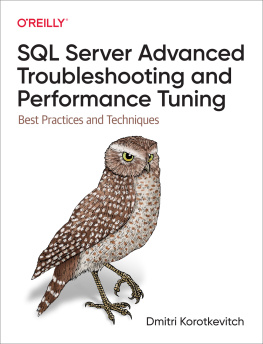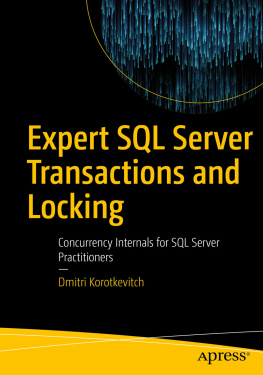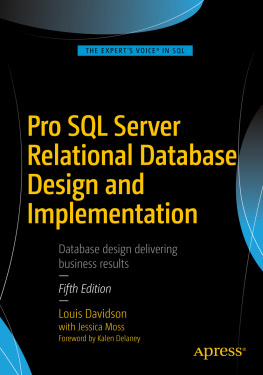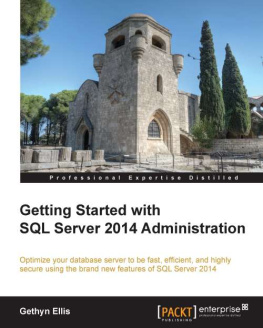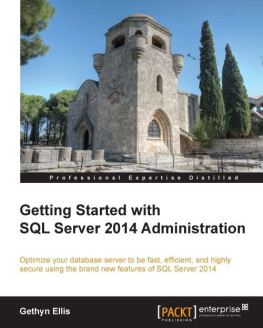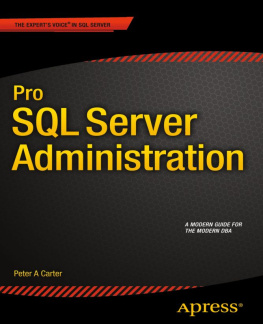Korotkevitch - Expert SQL Server In-Memory OLTP
Here you can read online Korotkevitch - Expert SQL Server In-Memory OLTP full text of the book (entire story) in english for free. Download pdf and epub, get meaning, cover and reviews about this ebook. City: Berkeley;CA;New York;NY, year: 2015, publisher: Apress, genre: Politics. Description of the work, (preface) as well as reviews are available. Best literature library LitArk.com created for fans of good reading and offers a wide selection of genres:
Romance novel
Science fiction
Adventure
Detective
Science
History
Home and family
Prose
Art
Politics
Computer
Non-fiction
Religion
Business
Children
Humor
Choose a favorite category and find really read worthwhile books. Enjoy immersion in the world of imagination, feel the emotions of the characters or learn something new for yourself, make an fascinating discovery.
- Book:Expert SQL Server In-Memory OLTP
- Author:
- Publisher:Apress
- Genre:
- Year:2015
- City:Berkeley;CA;New York;NY
- Rating:4 / 5
- Favourites:Add to favourites
- Your mark:
- 80
- 1
- 2
- 3
- 4
- 5
Expert SQL Server In-Memory OLTP: summary, description and annotation
We offer to read an annotation, description, summary or preface (depends on what the author of the book "Expert SQL Server In-Memory OLTP" wrote himself). If you haven't found the necessary information about the book — write in the comments, we will try to find it.
Expert SQL Server In-Memory OLTP — read online for free the complete book (whole text) full work
Below is the text of the book, divided by pages. System saving the place of the last page read, allows you to conveniently read the book "Expert SQL Server In-Memory OLTP" online for free, without having to search again every time where you left off. Put a bookmark, and you can go to the page where you finished reading at any time.
Font size:
Interval:
Bookmark:
- Optimize data storage for main memory: Data in In-Memory OLTP is not stored on on-disk data pages nor does it mimic an on-disk storage structure when loaded into memory. This permits the elimination of the complex buffer pool structure and the code that manages it. Moreover, indexes are not persisted on disk, and they are re-created upon startup when the data from memory-resident tables is loaded into memory.
- Eliminate latches and locks: All In-Memory OLTP internal data structures are latch- and lock-free. In-Memory OLTP uses a new multiversion concurrency control to provide transaction consistency. From a user standpoint, it behaves similar to the regular SNAPSHOT transaction isolation level; however, it does not use a locking or tempdb version store under the hood. This schema allows multiple sessions to work with the same data without locking and blocking each other and improves the scalability of the system, allowing it to fully utilize modern multi-CPU/multi-core hardware.
- Use native compilation: T-SQL is an interpreted language that provides great flexibility at the cost of CPU overhead. Even a simple statement requires hundreds of thousands of CPU instructions to execute. The In-Memory OLTP Engine addresses this by compiling row-access logic and stored procedures into native machine code.
Font size:
Interval:
Bookmark:
Similar books «Expert SQL Server In-Memory OLTP»
Look at similar books to Expert SQL Server In-Memory OLTP. We have selected literature similar in name and meaning in the hope of providing readers with more options to find new, interesting, not yet read works.
Discussion, reviews of the book Expert SQL Server In-Memory OLTP and just readers' own opinions. Leave your comments, write what you think about the work, its meaning or the main characters. Specify what exactly you liked and what you didn't like, and why you think so.




